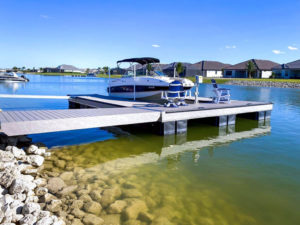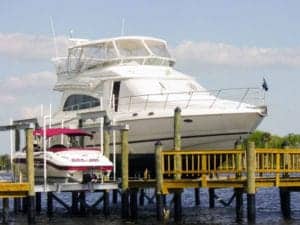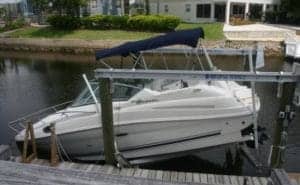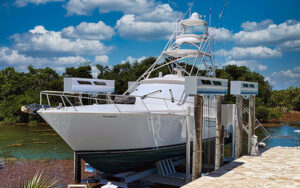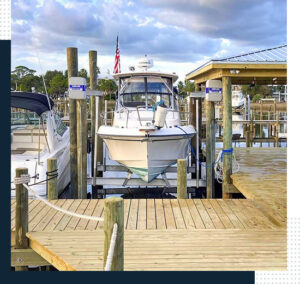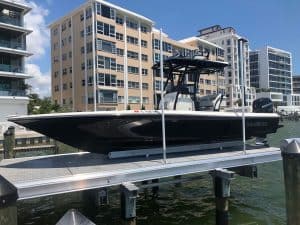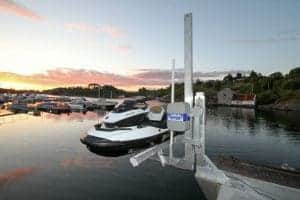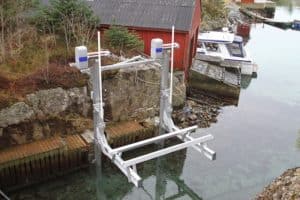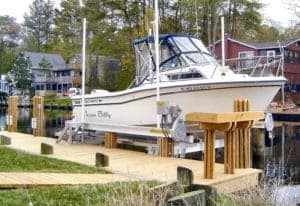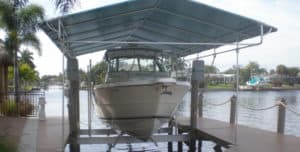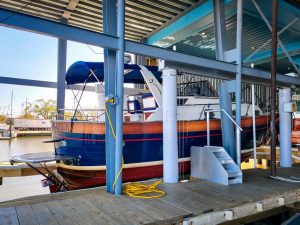How Cantilever Boat Lifts Work


How Are Vertical Boat Lifts Designed?
 Unlike cantilever boat lifts, vertical boat lifts are engineered to lift and store your vessel high above rough waters. Vertical boat lifts use a cable and pulley system to lower your boat.
IMM Quality’s vertical boat lifts use parallel upper beams that each contain a motor-driven shaft through their length. Four cables are wound around the shaft and connected to the four corners of the boat cradle. The cradle is then raised or lowered by a clockwise or counter-clockwise rotation of the shaft. In contrast, most cantilever lifts use a handwheel to raise and lower the lift and therefore do not require electrical power. However, by being manpowered, you have to be willing to exert the effort yourself.
Standard vertical boat lifts can accommodate boats with loaded weight that span from 4,500 pounds up to 250,000 pounds, securing them high above the choppy waves and corrosive salt water. Many offer both four-piling and eight-piling configurations, making them ideal for both shallow and deep-water applications. In contrast, cantilever lifts save money by not requiring the installation of pilings.
Because the cables bear the full weight of the boat, IMM Quality Boat Lifts has engineered our vertical boat lifts to use the mechanical advantage of pulleys to lessen the exerted force on the components. We use aluminum pulleys with a unique self-lubricating bearing that is maintenance-free. In fact, the vertical boat lifts engineered by IMM Quality Boat Lifts are considered the most efficient design for a cable-drawn lift for sale in the industry!
Check out the links below to explore each of our models in closer detail, including a photo gallery of each type of boat lift in action:
Unlike cantilever boat lifts, vertical boat lifts are engineered to lift and store your vessel high above rough waters. Vertical boat lifts use a cable and pulley system to lower your boat.
IMM Quality’s vertical boat lifts use parallel upper beams that each contain a motor-driven shaft through their length. Four cables are wound around the shaft and connected to the four corners of the boat cradle. The cradle is then raised or lowered by a clockwise or counter-clockwise rotation of the shaft. In contrast, most cantilever lifts use a handwheel to raise and lower the lift and therefore do not require electrical power. However, by being manpowered, you have to be willing to exert the effort yourself.
Standard vertical boat lifts can accommodate boats with loaded weight that span from 4,500 pounds up to 250,000 pounds, securing them high above the choppy waves and corrosive salt water. Many offer both four-piling and eight-piling configurations, making them ideal for both shallow and deep-water applications. In contrast, cantilever lifts save money by not requiring the installation of pilings.
Because the cables bear the full weight of the boat, IMM Quality Boat Lifts has engineered our vertical boat lifts to use the mechanical advantage of pulleys to lessen the exerted force on the components. We use aluminum pulleys with a unique self-lubricating bearing that is maintenance-free. In fact, the vertical boat lifts engineered by IMM Quality Boat Lifts are considered the most efficient design for a cable-drawn lift for sale in the industry!
Check out the links below to explore each of our models in closer detail, including a photo gallery of each type of boat lift in action:
- Alumavator Vertical Boat Lift: Economical, reliable, battle-tested chain drive lift
- Platinum Vertical Boat Lift: Maintenance-free, direct drive boat lift with bells and whistles
- Superlift Vertical Boat Lift: Rugged, industrial-duty gearless boat lift that is built for speed
How to Choose Cantilever Boat Lifts vs Vertical Lifts
When it is time to decide between cantilever boat lifts vs vertical lifts, there are several pros and cons for boat owners to consider. First, there’s the price point. At face value, cantilever boat lifts are the less expensive option, while vertical boat lifts require a larger up-front investment. However, upon closer examination, vertical boat lifts offer better overall value – and resale value – with proven durability, versatility and security that a cantilever boat lift just cannot match. The disadvantages of cantilever boat lifts also provide pause, with its limitations affecting lift height, capacity, suitability to saltwater and bottom conditions that could quickly eliminate this type of lift as a possibility for your home or boat. Then, there’s the extra hassle that comes with needing to move your lift into and out of the water with the changing seasons. Launching a boat stored on a cantilever lift is also much harder. Would you rather raise and lower your boat by hand with a cantilever lift or press a button on a remote control and let the vertical lift’s electrical motors do the work? You can set the height of the top beam so that it can be used as a step for easier boarding. As an added aesthetic advantage, IMM Quality’s top-beam vertical boat lifts can be set in a “low-profile” configuration. This allows you to deck your cradles and make a seamless wrap-around dock for easy access to your boat from all sides. It may sound like a minor feature at first, but when you want to quickly head for open waters, conveniences like these will save you precious time. One complaint many direct against vertical boat lifts is the increased need for maintenance, stemming from the reliance on weight-bearing cables. But unlike our competitors, IMM Quality Boat Lifts’ innovative vertical boat lifts have been engineered to require little to no maintenance, by design. Setting the standard for the industry, our vertical boat lifts are engineered and manufactured in-house to deliver consistent high-quality and longevity. If you are a boater who is debating whether to buy cantilever boat lifts vs vertical lifts, choose the vertical boat lift to maximize your investment. To learn more about the design, engineering and manufacturing of our vertical boat lifts, complete our CONTACT FORM or REQUEST A QUOTE and we’ll give you a call! READ MORE: Six Questions to Ask Your Boat Lift DealerFrequently Asked Questions (FAQs) about Cantilever Boat Lifts vs Vertical Lifts
Cantilever lifts are best suited for calm, freshwater environments and smaller boats, using leverage and a simple pulley system. Vertical lifts are designed for rougher waters, including saltwater, and can handle a wider range of boat sizes by lifting the boat higher above the waterline.
Cantilever lifts can suffer from quicker degradation due to corrosion and biological growth, as their structures remain submerged. Vertical lifts, typically made from aluminum, can avoid this by being raised out of the water.
They struggle with significant water level changes due to their limited lift height, making them less ideal for areas prone to such fluctuations.
Vertical lifts provide higher lift capacity, greater lifting height, durability in various water conditions, and generally require less manual effort to operate, making them a versatile and convenient option for many boaters.
Initially, vertical lifts are more expensive but offer better value over time due to their durability, versatility, and higher resale value, making them a worthwhile investment for many boat owners.


